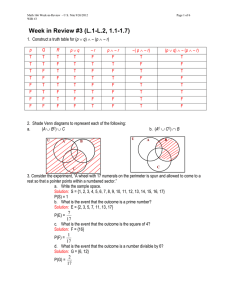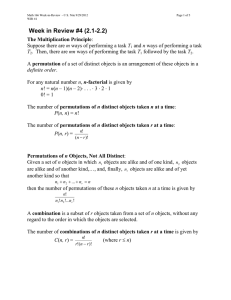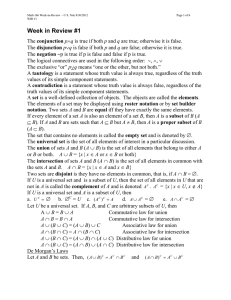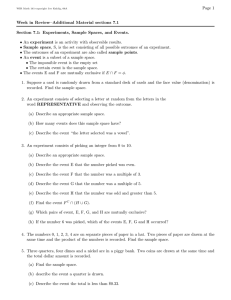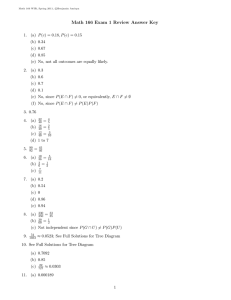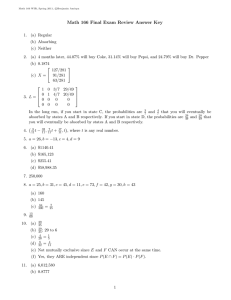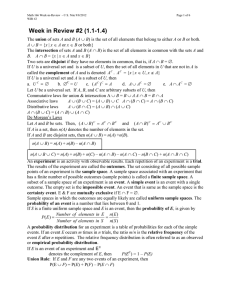Week in Review #3 (L.1-L.2, 1.1-1.7)
advertisement
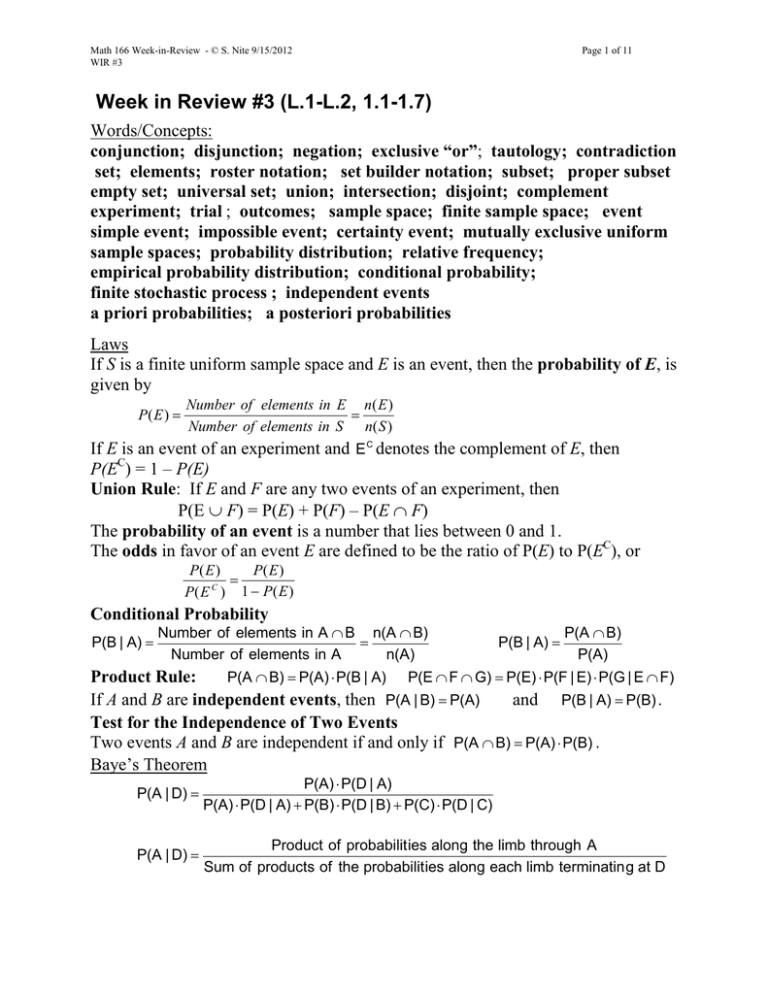
Math 166 Week-in-Review - © S. Nite 9/15/2012 WIR #3 Page 1 of 11 Week in Review #3 (L.1-L.2, 1.1-1.7) Words/Concepts: conjunction; disjunction; negation; exclusive “or”; tautology; contradiction set; elements; roster notation; set builder notation; subset; proper subset empty set; universal set; union; intersection; disjoint; complement experiment; trial ; outcomes; sample space; finite sample space; event simple event; impossible event; certainty event; mutually exclusive uniform sample spaces; probability distribution; relative frequency; empirical probability distribution; conditional probability; finite stochastic process ; independent events a priori probabilities; a posteriori probabilities Laws If S is a finite uniform sample space and E is an event, then the probability of E, is given by P( E ) = Number of elements in E n( E ) = Number of elements in S n( S ) If E is an event of an experiment and E C denotes the complement of E, then P(EC) = 1 – P(E) Union Rule: If E and F are any two events of an experiment, then P(E ∪ F) = P(E) + P(F) – P(E ∩ F) The probability of an event is a number that lies between 0 and 1. The odds in favor of an event E are defined to be the ratio of P(E) to P(EC), or P( E ) P( E ) = C P( E ) 1 − P( E ) Conditional Probability P(B | A) = Number of elements in A ∩ B n(A ∩ B) = Number of elements in A n(A) P(B | A) = P(A ∩ B) P(A) Product Rule: P(A ∩ B) = P(A) ⋅ P(B | A) P(E ∩ F ∩ G) = P(E) ⋅ P(F | E) ⋅ P(G | E ∩ F) and P(B | A) = P(B) . If A and B are independent events, then P(A | B) = P(A) Test for the Independence of Two Events Two events A and B are independent if and only if P(A ∩ B) = P(A) ⋅ P(B) . Baye’s Theorem P(A | D) = P(A) ⋅ P(D | A) P(A) ⋅ P(D | A) + P(B) ⋅ P(D | B) + P(C) ⋅ P(D | C) P(A | D) = Product of probabilit ies along the limb through A Sum of products of the probabilit ies along each limb terminatin g at D Math 166 Week-in-Review - © S. Nite 9/15/2012 WIR #3 Page 2 of 11 6. Construct a truth table for (p ∨ q) ∧ ∼ (p ∧ ∼ r) 7. Shade Venn diagrams to represent each of the following: a. (A ∪ BC) ∪ C U b. (AC ∪ CC) ∩ B A B C U A B C Math 166 Week-in-Review - © S. Nite 9/15/2012 WIR #3 Page 3 of 11 1. Consider the experiment, “A wheel with 17 numerals on the perimeter is spun and allowed to come to a rest so that a pointer points within a numbered sector.” a. Write the sample space. b. What is the event that the outcome is a prime number? c. What is the event that the outcome is the square of 4? d. What is the event that the outcome is a number divisible by 6? 2. Consider an experiment of rolling a pair of dice. What is the event that a. A sum of eight turns up? b. A sum less than five turns up? c. A sum of eight turns up or a two is showing? d. A sum of 4 or a sum of 10 turns up? 3. Consider an experiment of rolling a pair of dice. a. Give an example of two mutually exclusive events. b. Give an example of two events that are not mutually exclusive. 4. What is the probability of each of the events in # 1-2? Math 166 Week-in-Review - © S. Nite 9/15/2012 WIR #3 Page 4 of 11 5. Give the probability distribution for the following situation: A die was cast 200 times with the following results: Outcome Number of Times 1 35 2 28 3 29 4 36 5 33 6 39 6. From a survey involving 1,000 people in Houston, it was found that 500 people had tried Diet Pepsi, 600 had tried regular Pepsi, and 200 had tried both. If a resident of the city is selected at random, what is the probability that a. The resident has tried diet or regular Pepsi? b. The resident has tried either diet or regular Pepsi, but not both? 7. If 65% of a store’s customers are female and 80% of the female customers have charge accounts at the store, what is the probability that a customer selected at random is a female and has a charge account? 8. A single card is drawn from a standard 52-card deck. If event E is the drawn card is a spade and event F is the drawn card is a 8 or 9, are the two events independent? 9. If the odds in favor of Jamie attending class on Friday is 7/11, what is the probability that Jamie will skip class on Friday? Express your answer to the nearest tenth of a percent. Math 166 Week-in-Review - © S. Nite 9/15/2012 WIR #3 Page 5 of 11 10. A survey indicated that 68% of college students like a certain product. Based on the survey, find the probability that at least 25 college students in a sample of 30 like the product. 11. Find P(A∪C) by referring to the following tree diagram: C A .3 .62 D .45 C B D 12. Find the probabilities by referring to the following tree diagram: C .4 U .6 CC C .2 .5 .2 V .8 CC .3 C .6 W .4 CC a. b. c. d. P(C) e. P(V/ C C ) f. P(V∩C) g. P(C|W) P(C|U) P(V∪C) P(U|C) Math 166 Week-in-Review - © S. Nite 9/15/2012 WIR #3 Page 6 of 11 13. The probability of a pencil lead breaking during next test is .085. What are the odds in favor of a pencil lead breaking during the next test? 14. Suppose P(E∪F) = .68, P(E) = .38 and P(F) = .3. Are the events E and F independent? Why or why not? 15. A pair of fair dice is cast. What is the probability that the sum of the numbers falling uppermost is even given that one of the numbers is a 4? An experiment consists of selected a letter at random from the words SAMPLE SPACE. 16. Write the sample space for the experiment. 17. How many events are possible for the experiment? 18. What is the event that a letter chosen in the situation is a vowel? Math 166 Week-in-Review - © S. Nite 9/15/2012 WIR #3 Page 7 of 11 19. Past records in a certain city produced the following probability data on a driver being in an accident on a particular holiday: Rain (R) No Rain (RC) Totals Accident (A) .025 .015 No Accident (AC) .335 .625 .360 .640 .040 .906 1.000 Totals Find the probability of a. An accident, rain or no rain. b. Rain, accident or no accident. c. An accident and rain d. An accident, given rain. 20. A single card is drawn from a standard 52-card deck. If event E is the drawn card is a spade and event F is the drawn card is a face card, are the two events independent? 21. A space shuttle has four independent computer control systems. If the probability of failure (during flight) of any one system is .001, what is the probability of failure of all four systems? 22. A fair die is rolled 5 times. What is the probability of getting a 6 on the 5th roll, given that a 6 turned up on the preceding 4 rolls? 23. A fair die is rolled 5 times. What is the probability that the same number turns up every time? Math 166 Week-in-Review - © S. Nite 9/15/2012 WIR #3 Page 8 of 11 24. Find the probabilities by referring to the following tree diagram: C .4 U .6 CC C .2 .5 .2 V .8 CC .3 C .6 W .4 CC a. P(U|C) C b. P(V/ C ) c. P(W|C) d. P(U\ C C ) e. P(V|C) f. P(W| C C ) Math 166 Week-in-Review - © S. Nite 9/15/2012 WIR #3 Page 9 of 11 24. In a study to determine frequency and dependency of color-blindness relative to females and males, 1000 people were chosen at random and the following results were recorded: Female (F) Male ( F C ) Totals Color-Blind, C 2 24 26 C 518 456 974 Normal, C Totals 520 480 1000 a. What is the probability that a person is a woman, given that the person is color-blind? b. What is the probability that a person is color-blind, given that the person is a male? c. Are the events color-blindness and male independent? d. Are the events color-blindness and female independent? 25. A new, inexpensive skin test is devised for detecting tuberculosis. To evaluate the test before it is put into use, a medical researcher randomly selects 1000 people. Using precise but more expensive methods already available, it is found that 8% of the 1000 people tested have tuberculosis. Now each of the 1000 subject is given the new skin test and the following results are recorded: The test indicates tuberculosis in 96% of those who have it and in 2% of those who do not. Based on these results, what is the probability of a randomly chosen person having tuberculosis given that the skin test indicates the disease? What is the probability of a person not having tuberculosis given that the skin test indicates the disease? Math 166 Week-in-Review - © S. Nite 9/15/2012 WIR #3 Page 10 of 11 26. An urn contains 5 white and 4 red balls. Two balls are drawn in succession without replacement. If the second ball is white, what is the probability that the first ball was white? 27. Urn 1 contains 3 white and 7 red balls, and urn 2 has 5 white and 4 red balls. A ball is drawn from urn 1 and placed in urn 2. Then a ball is drawn from urn 2. If the ball drawn from urn 2 is red, what is the probability that the ball drawn from urn 1 was red? 28. If two cards are drawn in succession from a standard 52-card deck without replacement and the second card is a heart, what is the probability that the first card is a heart? 29. A manufacturer obtains clock-radios from three different subcontractors: 20% from A, 40% from B, and 40% from C. The defective rates for these subcontractors are 1%, 3%, and 2%, respectively. If a defective clock-radio is returned by a customer, what is the probability that it came from subcontractor A? From B? From C? Math 166 Week-in-Review - © S. Nite 9/15/2012 WIR #3 Page 11 of 11 1, 1 1, 2 1, 3 1, 4 1, 5 1, 6 2, 1 2, 2 2, 3 2, 4 2, 5 2, 6 3, 1 3, 2 3, 3 3, 4 3, 5 3, 6 4, 1 4, 2 4, 3 4, 4 4, 5 4, 6 5, 1 5, 2 5, 3 5, 4 5, 5 5, 6 6, 1 6, 2 6, 3 6, 4 6, 5 6, 6
